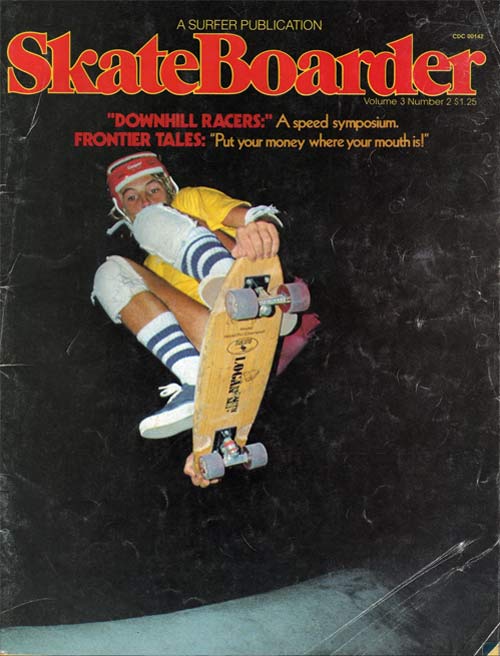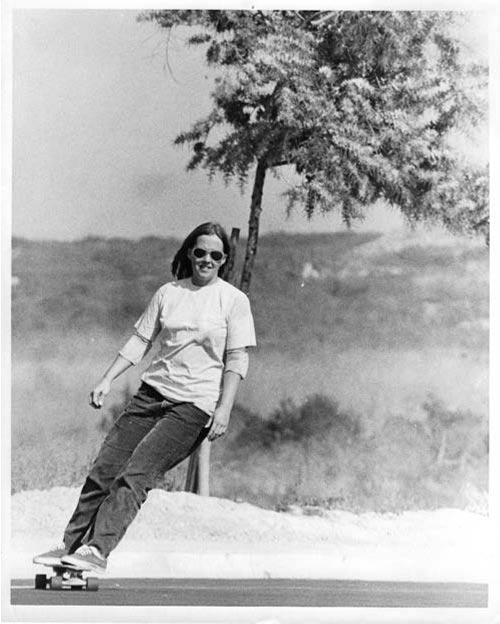
When I bought my first copy of SkateBoarder magazine in December 1976, I recall reading an article from Di Dootson. At the time, Di was heavily into the skateboard scene and I was strictly a newbie. Over the next several years I would see her articles and race reports. I was a little envious that Di was down in California, seemingly at the epicenter of all things skateboarding. Fast-forward almost four decades later, and I finally got a chance to meet Di in person. We became friends, and at last year’s Catalina Island Classic I asked her to come on board to write a piece for CW. For those readers with long-term memories, reading Di’s words will feel like déjà vu. For our younger readers, I am hoping Di’s love for skateboarding will resonate with you. Her roots in skateboarding run deep, and her journey back to those roots is a tale worth telling. – Ed.
 I didn’t start doing downhill until I was 27 years old. From there, I did some slalom racing at La Costa and in Vail, Colorado, on the Another Roadside Attraction racing circuit. I am still addicted to the feeling you get when racing down a hill. There were a lot of riders at Black Hill (in San Diego County) in 1975. This was where many manufacturers did their research and development. Pro riders came to test equipment and improve their skills. Companies such as Bahne, Cadillac Wheels, G&S, Tracker Trucks, Gullwing, Turner and Logan Earth Ski were at La Costa every week. Soon slalom cones showed up.
I didn’t start doing downhill until I was 27 years old. From there, I did some slalom racing at La Costa and in Vail, Colorado, on the Another Roadside Attraction racing circuit. I am still addicted to the feeling you get when racing down a hill. There were a lot of riders at Black Hill (in San Diego County) in 1975. This was where many manufacturers did their research and development. Pro riders came to test equipment and improve their skills. Companies such as Bahne, Cadillac Wheels, G&S, Tracker Trucks, Gullwing, Turner and Logan Earth Ski were at La Costa every week. Soon slalom cones showed up.
Having the type of personality to organize c haos, I ran those La Costa races for three years – not counting when we were at pro events around the country. With my experience at La Costa, I was hired to run slalom and downhill for many pro events: Long Beach, Akron, Kona Pro-Am, Sensation Basin WRAPS (Wild Radical Annual Party Session), Hang Ten, Cow Palace and others across the country.
haos, I ran those La Costa races for three years – not counting when we were at pro events around the country. With my experience at La Costa, I was hired to run slalom and downhill for many pro events: Long Beach, Akron, Kona Pro-Am, Sensation Basin WRAPS (Wild Radical Annual Party Session), Hang Ten, Cow Palace and others across the country.
I judged pro freestyle contests at Magic Mountain, Oceanside and more. I wrote many articles for SkateBoarder magazine – mostly competition coverage. I wrote the Pacific Skateboard Association Freestyle Contest Guidelines. I helped Barry Segall of SkaBo with the two tapings of the CBS TV show “Battle of the Sexes.” I wrote for Skate & Surf magazine. I worked with Henry Hester on the first two of his Hester Series bowl contests. In 1976 I started the National Skateboard Review with Peggy Turner, wife of legendary board maker Bobby Turner, the designer of the Turner Summer Ski. The Review started partly because the racers kept asking how fast they went each week and I got tired of trying to remember and track the results and times for everyone. We printed the race results in a one-page handout called Skateboard Racing News. After a while Peggy didn’t want to continue, but I sure did. She gave me the OK to carry on and I renamed the newspaper the National Skateboard Review.
You have to remember this was in 1976: no cellphones, no email, no Internet. Long-distance calls could cost up to $30. The NSR became the voice for local skaters all over the country. It started as a one-page publication, but at its closure in 1979, it had grown to 22 pages. For that last issue I added color headlines (sounds easy now, but again, remember this was the ’70s). We published race results, photos, drawings, and letters from all over the country. Soon there was a regular section in the NSR called “Let’s Hear From,” where I would print what folks had sent me.
Three years later, I closed up shop in the summer of 1979 when companies, hit hard by the closure of skateparks, slowly stopped buying ads in the NSR. My last edition was April–May 1979. My heart was broken, and I left the Carlsbad area and moved to a little cabin in the hills in Jamul, east of San Diego. I returned to my previous career as a recreation therapist and packed away my photos, copies of the NSR and business records Ihad remaining from my days submerged in the skate industry. I remained friends with some folks from skateboarding, but in truth, I ran away. In doing so, I missed at happened in the ’80s and ’90s.
Local skate events had no voice for quite a long time. Not until the Internet began to flourish did amateurs have a way to promote themselves. At that point, they could self-publish. In 2004, I heard of a slalom race in La Costa. My first thought was, “What?! Without me?!” I found the spot and discovered all my old friends. I had missed Henry Hester’s slalom races that he held a few years earlier and was so bummed when I learned about them. But those were the only ones I missed. I was so happy to find that race in ’04.
An amazing thing happened at that race. People I didn’t even know came up to me to thank me for the National Skateboard Review. They explained how they would wait impatiently for the next issue to arrive. All those greetings brought tears to my eyes. The years fell away as I felt I was coming home to my skateboard family.
Since that race in ’04, I continue to make contact with people who sent me information for the NSR back in the day. Steve Caballero tells me the NSR was his first cover photo. Tim Stahl tells me that when he was an aspiring young photographer, my use of his photos started his career – he is a professional photographer today.
I had the honor of going to Washington, D.C. in 2013 to be part of Innoskate, a celebration of invention and creativity in skate culture. I was asked to submit a full collection of the NSR into the archives of the Smithsonian Institution. This honor was almost overwhelming. I thanked Jane Rogers, associate curator at the Smithsonian, for including me. Her reply? “You belong here.” So, all of you who made contributions to the National Skateboard Review, please know your words and photos are all in the Smithsonian. They liked me and my newspaper as an example of how innovative Americans changed the culture of America. They recognize skateboarding as an essentially American invention that has affected sport, art, fashion and design in the U.S. It is clear that today’s skateboarders care about and respect the origins of their sport. My articles will bring you a historical vantage as we focus on skateboarding today.
Article courtesy of Michael Brooke of Concrete Wave Magazine
